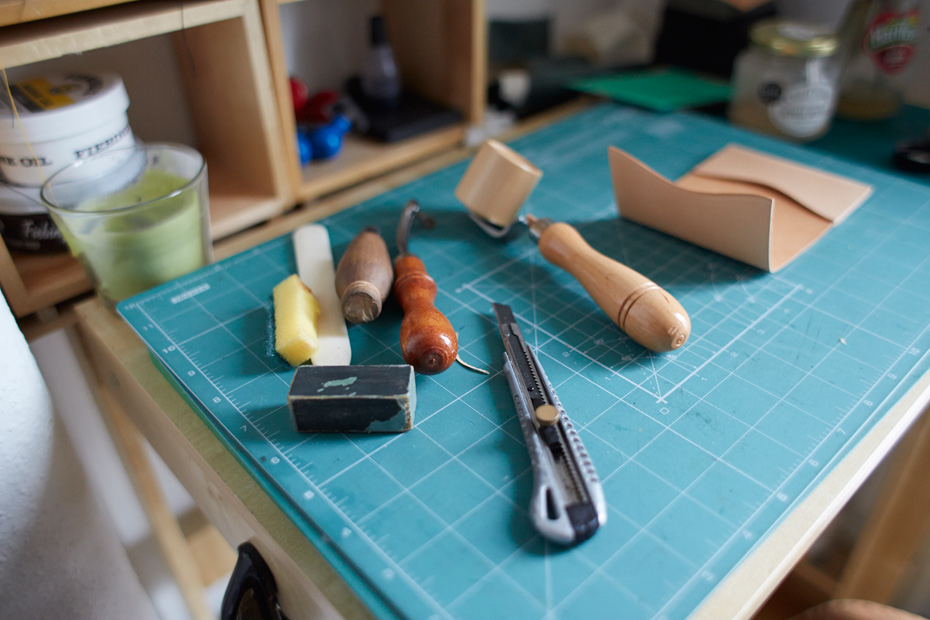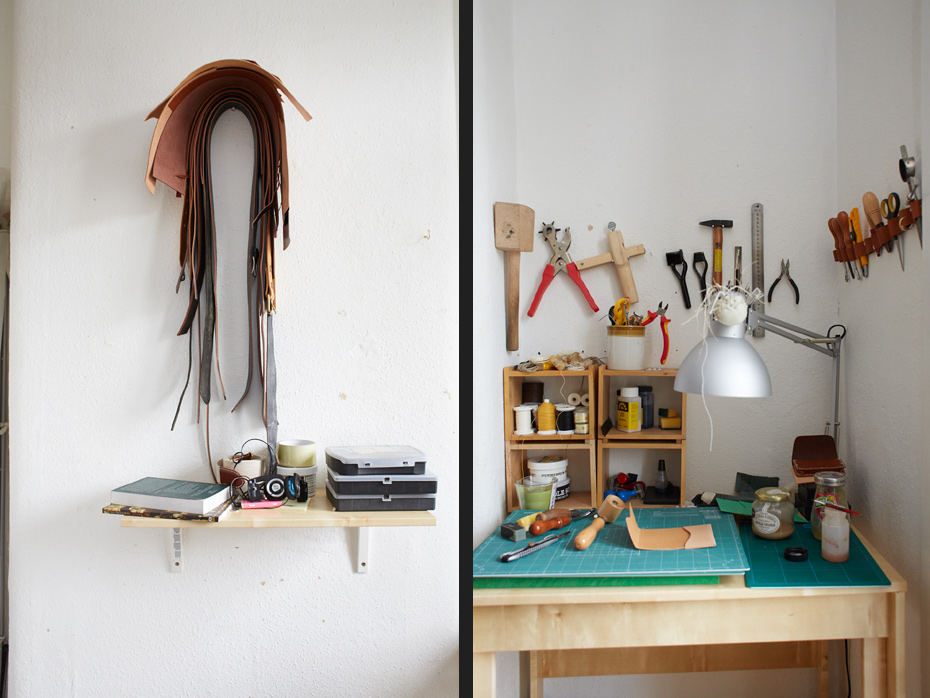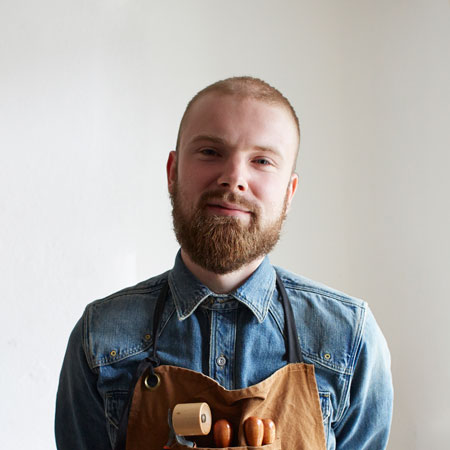- Artisan Jonatan Staniec explains how he ended up making his beautiful hand-made range of leather products from his home in North London
 Words Betty Wood
Words Betty Wood
Photography Maria SpannAbove: The tools that Jonatan uses to score, cut and seal the leather on his cardholderJonatan Staniec is a man who practices modesty; his bedroom doubles as his workshop and is furnished in spartan fashion. In the corner, a compact work station comprising of a small desk and wicker-panelled chair is set up above which hangs a line of tools, mounted on the wall. There’s a leather coin tray on the bedside table and a wallet on top of the fireplace, which, later he will show me, pointing out where he’s added, re-stitched and re-sewn panels onto it so it sits more comfortably in his jean pocket. From atop the armoire peeks a roll of fresh, vegetable tanned cowhide, the type he currently prefers to work with (sourced, like all of his materials and fittings from the UK). Unfolding the skin for me to feel – it’s a tactile, porous leather that smells wonderful – he takes a strip of if he’s already cut ready to begin his demonstration.

 As he begins work on a cardholder, he tells me that he is a second-generation leather worker: “My dad was a tailor originally. In the mid-80s my parents started struggling because furs and independent tailoring started to fade in popularity – there was no demand. I don’t know how it happened, but my dad came up with the idea to work with leather, mixing it with fabrics. He started making bags and rucksacks.” One of his father’s rucksacks, a bag of 20 years vintage, hangs on the back of the door. He takes it down from the hook, turning it over to show me the padding and the complications of its designs. “It was a peculiar time; he knew how to make clothes, but he wasn’t a designer, he didn’t have a degree. He just used his own creativity and spontaneity.” Well, that and machinery, which is perhaps the biggest departure from his family’s Poland-based company set-up, which continues on today in a very compact, modest form.
Above: Jonatan shows how the leather changes from a peach pale colour over time to the rich patina on the right
As he begins work on a cardholder, he tells me that he is a second-generation leather worker: “My dad was a tailor originally. In the mid-80s my parents started struggling because furs and independent tailoring started to fade in popularity – there was no demand. I don’t know how it happened, but my dad came up with the idea to work with leather, mixing it with fabrics. He started making bags and rucksacks.” One of his father’s rucksacks, a bag of 20 years vintage, hangs on the back of the door. He takes it down from the hook, turning it over to show me the padding and the complications of its designs. “It was a peculiar time; he knew how to make clothes, but he wasn’t a designer, he didn’t have a degree. He just used his own creativity and spontaneity.” Well, that and machinery, which is perhaps the biggest departure from his family’s Poland-based company set-up, which continues on today in a very compact, modest form.
Above: Jonatan shows how the leather changes from a peach pale colour over time to the rich patina on the rightBeyond the tools on his wall, Jonatan uses no machinery to make his products, which include wallets, belts, billfolds, cardholders, iPad and phone cases. Instead, using saddlery tools, and stitched using a traditional two-handed technique, each item is hand-cut, and made by Jonatan. “It was a conscious decision,” he explains, “and difficult to learn.”
“Before I thought about using leather, I perceived it as something lame” he begins laughing, taking me on his journey from warehouse worker to artisan. I was living in the south of Poland” he says, alluding to a difficult personal time, “and I moved back to my hometown for a year to live with my parents. My dad suggested many times that I should learn leatherwork, as I have such a great opportunity. I was browsing the Internet one night, and I discovered one-man operations working from their flats, making quality leather goods. I was really inspired by the American craft movement and realised that classic leather work could be really interesting and cool.”

 Left: Belt straps and leather pieces cut ready to be worked on
Left: Belt straps and leather pieces cut ready to be worked on
Right: Jonatan’s work station with tools hanging above
 ”We live in era where mass consumerism is very strong” says Jonatan,”we want to buy things fast, cheap and often. It’s a negative – ethically, economically and environmentally. I believe it’s important to know why you’re buying something, who made it and how that was made.”
”We live in era where mass consumerism is very strong” says Jonatan,”we want to buy things fast, cheap and often. It’s a negative – ethically, economically and environmentally. I believe it’s important to know why you’re buying something, who made it and how that was made.”
So Jonatan decided to try making wallets himself.
But working on a small scale in Poland proved difficult, even with the benefit of his father’s workshop available to him: “Independent, artisanal leather work is something that is becoming extinct in Poland. I couldn’t find any suppliers there with regards to the saddlery tools, hardware and it was really hard to find a small wholesaler that was willing to sell small quantities of leather – they had minimum orders I couldn’t meet. So I started to buy leather, hardware and tools from England.”
Surprisingly, given his family background, Jonatan taught himself the majority of the skills he needed for his fledgling hobby. “My dad taught me the basics, and told me to do it myself. I had the space, and if I needed help, he was here, but mostly I used forums online. This is where I got the idea of working with my hands, using only traditional techniques of sewing and cutting, which my dad wasn’t familiar with.”
Top: Pins used for threading. Jonatan uses a range of threads for his stitching, including a vintage French linen. He coats them in beeswax, as when the wax heats, it seals the stitches making it extra durable
Bottom: Demonstrating the two-handed technique


- “I could make this in two hours maximum” he says, running the overstitch wheel along the edge of the leather panel on the cardholder he’s constructing. “This is the most simple thing I make – a wallet is more complicated”. He takes his own wallet from the mantelpiece, turns it over and shows me: “This is my new product, it’s a prototype, and it’s a good example of how I make and develop my products – I make something, and then I see how it works”. He’s added a new flap and removed a button to improve its function.
The leather, worn and warm from use has taken on a rich patina. Vegetable leather changes colour over time with heat and light, making each item individual to its owner, and adding a delightful element of surprise to the product. Less surprisingly, this is why Jonatan chose it as his staple leather. And his products are developing a following of their own. “I came to London with a bagful of handmade wallets. At the time I was going from store to store and speaking with the managers; I visited lots of stores in Shoreditch and central London, but Labour and Wait were the first store seriously interested in my goods. We chatted and I told them about myself – they said they would launch it. I sent them pictures and that’s how it started.”
Turning the conversation to the future of his business, Jonatan is philosophical: “With M.E.S, I want to help revive the traditional way of supporting local craftsmanship. In the past, when someone wanted to buy a purse or a belt, they wouldn’t go to a shopping mall – they’d go to their local leather artisan.” Selling online through his own store, as well as at selected independent retailers around London, is a fittingly modern way of achieving this goal.

“And,” he finishes, pulling a final stitch, “you know, quality leather goods are beyond trends and fashion – they always were and always will be in demand. I want to continue bringing a positive impact to the system by creating honest, ‘made here’ products in London.”
Subscribe to Port Magazine annually and receive each issue to your door.
Get PORT in print



